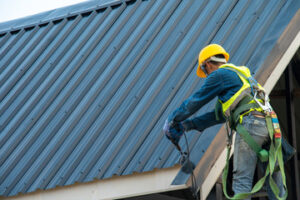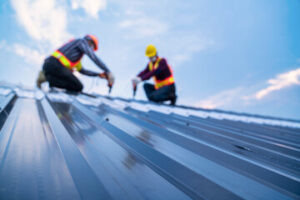While shingles are designed to resist the sun’s heat, the wear and tear of everyday use can cause them to chip or crack. Regular inspections and maintenance help prevent these problems before they escalate.

Trimming trees is another important roofing maintenance item. Branches that overhang the roof can touch or rub against it during storms, so they should be pruned regularly. Keep reading the article below Learn More.
The roof flashing provides a critical seal at the joints of a pitched roof. It consists of metal strips, usually aluminum or galvanized steel, that connect the roof to the underlying framing. When properly installed, it should expand and contract with the changing weather without leaking or becoming damaged.
It’s important to regularly inspect the flashing to ensure it is still intact and sealing the penetrations of your roof like chimneys, skylights, vents, or exhaust fans. You should also check the flashing for any water stains or discoloration on your ceiling or walls, which is a clear sign of leakage. You can easily identify a flashing leak by sending someone up in the attic with a garden hose to spray down on the areas of the roof that intersect with the flashing (like chimneys and skylights). If they notice any water infiltration, it’s time to call for a roofing professional.
Over time, heat and cold exposure can cause metal flashing to warp and loosen. Natural occurrences like high winds can also pull up or knock flashing out of place. Often, this happens around penetrations of the roof like chimneys, vents, or skylights where the flashing is exposed to a lot of pressure.
Flashing leaks are typically caused by holes in the metal that allow water to enter the home, and are typically caused by corrosion or wear from the shingle underneath. In most cases, a hole in the flashing can be easily repaired by cutting a piece of flashing several inches larger than the hole and then covering it with roof cement to form a watertight seal.
If you notice rust or corrosion on your roof flashing, it’s important to wipe away any sharp edges and cover the area with a fresh coat of roof cement. It’s also important to keep debris from building up around the flashing, as this can trap moisture against the metal and cause deterioration.
Lastly, make sure that the flashing at any roof penetrations is adequately sized for the size of the pipe. If the flashing collar is too small for the pipe’s diameter, it will put excessive stress on the collar and lead to leaks.
Inspect the Gutters
Guttering is an essential element of roof maintenance and should be inspected regularly to ensure that it is doing its job. Gutters are designed to direct water away from a house and help prevent damage to the foundation, walls, roof, and surrounding landscape. Without gutters, rainwater can saturate the soil around a home and wick up to the foundation, where it can cause wood rot and mold. Gutter clogs can also be problematic, causing standing water to build up and overflow the gutter system.
When inspecting your gutters, make sure to take proper ladder safety precautions, and consider enlisting the help of a friend. Observe ladder safety rules, such as maintaining three-point contact with the ground and using stabilizing devices whenever possible. Also, always use non-slip shoes and a harness when climbing a ladder, and be sure to wear protective eyewear when working on the roof.
Start your inspection by examining the gutters from the ground, making note of any sections that appear lower or higher than other sections. Also, look for sagging sections and any areas that appear loose or detached from the fascia board. Then, examine the gutters themselves for clogs, loose sections, and signs of corrosion or other damage. A good way to check the condition of a gutter is to run a garden hose over the gutters and downspouts to see how easily the water flows out.
Finally, examine the open valley metal for rust and to be sure that it is sealed with roof cement or caulking. It is important to address any problems with your roof and gutters right away to keep small, easily repairable issues from escalating into more serious, costly repairs. A good maintenance plan should include regular roofing inspections and a schedule of routine tasks. Many of these can be accomplished with in-house personnel, while specialized maintenance or work that is covered by an active warranty should be contracted out to a professional roofing contractor. In addition, a written record of maintenance is a valuable tool for submitting insurance claims and addressing warranty concerns.
Inspect the Soffits
Keeping the soffit and fascia well-maintained is crucial for the health of your roofline. They are responsible for directing water away from the home, protecting the structure of the roof, and preventing moisture damage to the woodwork around the house. It is easy to overlook issues with the soffit and fascia, such as cracking or discolouration, but these are early warning signs of potential problems.
Checking the soffits and fascia regularly can help you identify and address issues before they become serious problems that require costly repairs. Look for the following:
Visible Cracks or Holes
Small cracks or holes in the soffit can allow water to infiltrate and cause damage. These should be repaired promptly to prevent the problem from worsening.
Peeling Paint
Fading or peeling paint on the soffit and fascia boards is another sign of moisture damage. If left untreated, this could lead to mold or mildew growth and rot.
Sagging or Drooping Fascia Boards
If the fascia boards begin to sag, it could indicate that they are no longer structurally sound. This may be due to a buildup of moisture or the weight of clogged gutters pulling on them.
Insect or Rodent Infestation
Look for evidence of pest infestation in the soffit and fascia, including droppings, gnawing marks, and nests. These can be exacerbated by poor ventilation in the attic, which allows heat and moisture to build up in the attic space.
Whether you have a wood, aluminum, or vinyl soffit, you should replace it when there is rotting or mold damage. If you have a wood soffit that is rotted or has extensive discoloration, consider replacing it with a fiber cement soffit to avoid maintenance issues in the future.
Before attempting to replace a soffit, make sure you have all the right tools and are on a stable ladder. Use a pry bar to carefully remove the damaged section and be careful not to damage the adjacent areas or the fascia. If the soffit is nailed in place, you will need to remove the nails with a hammer. Minor damage, such as minor rot and isolated areas of peeling paint, can be fixed with a repair kit, but extensive rot or widespread damage will require cutting out and replacing the soffit entirely.
Clean the Roof
The roof is often out of sight, so it’s easy to forget that a dirty-looking or damaged roof can detract from the curb appeal of your home. Additionally, a build-up of debris and moss or algae can cause deterioration of the shingles and lead to leaks. Fortunately, regular cleaning can prevent these problems and extend the life of your roofing materials.
Whether your roof is made of shingle or tile, it needs to be cleaned on a regular basis. To do so, you’ll need to have the proper equipment, including a sturdy ladder, safety harness and gloves. It’s also a good idea to have a spotter who can hold the ladder while you work. In addition, tarps or sheets should be used to protect the surrounding landscaping and yard from splashback of cleaning solutions.
Begin by removing any loose debris from the surface of your roof. This will prevent it from becoming discolored during the cleaning process. Then, choose a day with low winds and sunshine to get started. If you’re using a chemical solution, be sure to consult with a professional or the manufacturer to ensure that it is safe for your specific roof type.
Prior to applying the cleaner, lightly wet the roof with a garden hose. This helps prevent the solution from drying too quickly and gives it a better chance to penetrate and break down stains. After applying the cleaner, let it sit according to the manufacturer’s instructions. Once the cleaning time has passed, rinse thoroughly using a hose or pressure washer at a low setting. This will wash away the cleaner, as well as any lingering grime.
Finally, inspect the roof for any areas that require repair or replacement. Missing or broken shingles should be replaced right away. They not only take away from the appearance of your home, but they can allow moisture to seep into your walls and foundation, causing expensive damage that will require major repairs. Moreover, many roof manufacturers require regular cleaning to maintain their warranties. If you ignore this requirement, you could end up paying for expensive out-of-pocket repairs if your roof fails sooner than expected.
